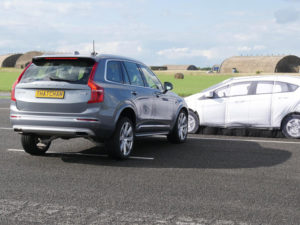Progress on new vehicle safety standards but not infrastructure safety
Industry and transport ministers from the 28 EU Member States have set out their official responses to three key pieces of road safety legislation, which has seen a mixed response.

The vehicle safety standards plans would see 11 different safety technologies be required on new cars within the next three years
Under the announcements, EU ministers of industry have given their endorsement by EU ministers of industry of a new package of mandatory minimum vehicle safety standards including the mandatory fitting of Automated Emergency Braking (AEB) and Intelligent Speed Assistance (ISA), as already agreed on by Member States.
Antonio Avenoso, executive director of ETSC said: “If this legislation is passed, together with the European Parliament, in the form it was proposed, it will prevent 25,000 people from dying over 16 years – a massive step forward for road safety. We strongly urge members of the European Parliament to guarantee this package is passed without being watered down.”
Meanwhile, Roza Thun, the MEP responsible for agreeing the European Parliament’s position on the vehicle safety regulation has published her draft report, which is now subject to amendments and a vote in the Internal Market (IMCO) committee on 20 February. Mrs Thun broadly supports all the measures proposed by the European Commission, but has added several improvements.
However, the ETSC has said the news on infrastructure safety rules was not positive.
In a text approved at the Transport Council meeting in Brussels, EU Member States introduced weaker language on three key elements of the European Commission’s proposal from May 2018, which could substantially weaken the potential of the new rules to reduce deaths and serious injuries on European roads.
The legislation is an update to existing EU safety requirements that currently only apply to major European motorways known as the Trans-European Transport Network (TEN-T) of roads. The existing requirements ensure governments carry out regular road safety audits, identify high-risk sites and prioritise safety when building new roads. A total of 18 EU Member States already apply the rules to other roads on a voluntary basis.
The European Commission had proposed to extend the rules to all primary roads in the EU. The ETSC and other organisations have been calling for main urban and main rural roads to be covered, as many more people die in collisions on these types of roads than on motorways.
But transport ministers have declared that each individual Member State should only be obliged to apply the rules to the TEN-T network and roads that were funded by the EU. The choice of other roads to be included would be left to Member States, leaving the possibility that some would propose the bare minimum, or only roads that already meet high safety standards.
The European Commission had also proposed to develop general performance standards for road signs and road markings across Europe. Although the ETSC urged for these to take the form of legally-binding minimum performance standards, transport ministers have called on the Commission to produce a report on the issue instead.
Ellen Townsend, policy director of ETSC said: “If transport ministers continue with this position, they will be doing precious little to change the status quo: 25,000 deaths a year on EU roads, with virtually no improvement over the last three years. We strongly urge the European Parliament to put forward a text that substantially improves road safety in Europe and hope that this will be reflected in the final deal agreed on this legislation early next year.”
At the same meeting, Transport ministers also agreed a position on controversial new rules on lorry driver working hours and rest times. The ETSC has warned that the proposed changes could lead to higher levels of fatigue and a consequently lower level of safety.

